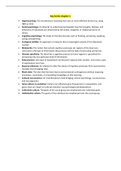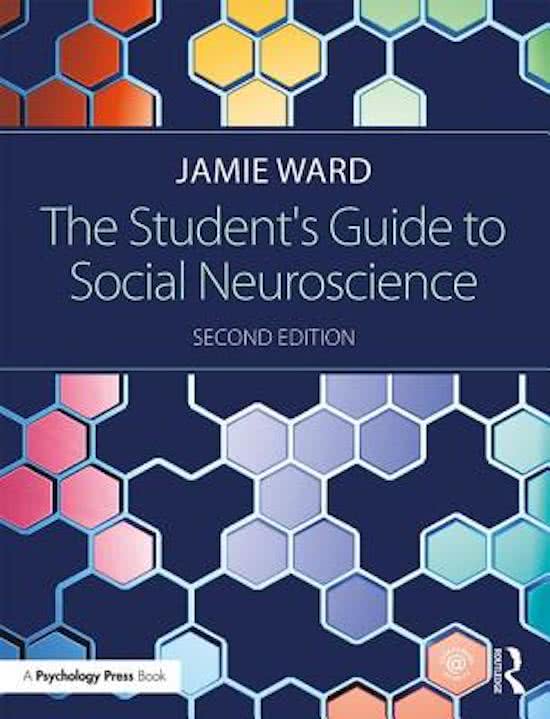Key terms chapter 1
• Hyperscanning: The simultaneous recording from two or more different brains (e.g. using
fMRI or EEG)
• Social psychology: An attempt to understand and explain how the thoughts, feelings, and
behaviors of individuals are influenced by the actual, imagined, or implied presence of
others.
• Cognitive psychology: The study of mental processes such as thinking, perceiving, speaking,
acting, and planning.
• Ecological validity: An approach or measure that is meaningful outside of the laboratory
context.
• Modularity: The notion that certain cognitive processes (or regions of the brain) are
restricted in the type of information they process and the type of processing carried out.
• Domain specificity: The idea that a cognitive process (or brain region) is specialized for
processing only one particular kind of information.
• Reductionism: One type of explanation will become replaced with another, more basic, type
of explanation over time.
• Reverse inference: An attempt to infer the nature of cognitive processes from neuroscience
(notably neuroimaging) data.
• Blank slate: The idea that the brain learns environmental contingencies without imposing
any biases, constraints, or preexisting knowledge on that learning.
• Cultural neuroscience: An interdisciplinary field bridging cultural psychology, neurosciences,
and neurogenetics
• Gene-culture co-evolution: Culture can influence gene frequencies in a population, and
genes have an impact on cultural evolution via psychological predispositions.
• Collectivist culture: The goals of the social group are emphasized over individual goals.
• Individualist culture: The goals of the individual are emphasized over the social group.
, Key terms chapter 2
• Temporal resolution: The accuracy with which one can measure when an event is occurring.
• Spatial resolution: The accuracy with which one can measure where an event is occurring.
• Invasiveness: Whether or not the equipment is located internally or externally.
• Mental chronometry: The study of the time-course of information processing in the human
nervous system.
• Speed–accuracy trade-off: If people are forced to respond faster, they will tend to be less
accurate.
• Preferential looking: In infant research, a number of stimuli (normally two) are presented
and the amount of time that the infant spends looking at each of them is scored.
• Habituation: In infant research, the same stimulus (or the same kind of stimulus) is
presented repeatedly and the infant’s attention towards the stimulus (measured in terms of
looking time) diminishes.
• Inter-rater (or inter-observer) reliability: The extent to which two independent observers
generate the same answers.
• Blind scoring: The observer is unaware of the status of the event that is being scored.
• Masking: The presentation of junk visual material after a stimulus (to eliminate persistence
of a visual image).
• Reliability: The extent to which the same measure would yield the same results if repeated.
• Acquiescence bias: A tendency to respond affirmatively in surveys, irrespective of the
content of the question
• Factor analysis: A statistical method for reducing a data set (e.g. in questionnaires, 20
questions may be grouped into a smaller number of factors)
• External validity: The extent to which a measure relates to something useful in ‘real life’
• Type I error: Getting a significant result in a statistical test when, in fact, there is no real
effect
• Type II error: Getting a nonsignificant result when in fact there is a real effect
• Neurons: A type of cell that makes up the nervous system.
• Dendrites: Branching structures that receive information from other neurons.
• Axon: A branching structure that carries information away from the cell body towards other
neurons and transmits action potentials.
• Synapse: The small gap between neurons in which neurotransmitters are released,
permitting signaling between neurons.
• Action potential: A sudden change in the electrical properties of the neuronal membrane in
an axon.
• Neurotransmitters: Chemical signals that affect the synaptic functioning of neurons.
• Autonomic Nervous System (ANS): A set of nerves located in the body that controls the
activity of the internal organs.
• Somatic nervous system: Part of the peripheral nervous system that coordinates muscle
activity.
• Sympathetic system: A division of the ANS that increases arousal (increased heart rate,
breathing, pupil size) but decreases functions such as digestion.
• Parasympathetic system: A division of the ANS that has a resting effect (decreased heart
rate, breathing, pupil size) but increases functions such as digestion.
• Skin Conductance Response (SCR): Small changes in conductivity as a result of mild sweating






